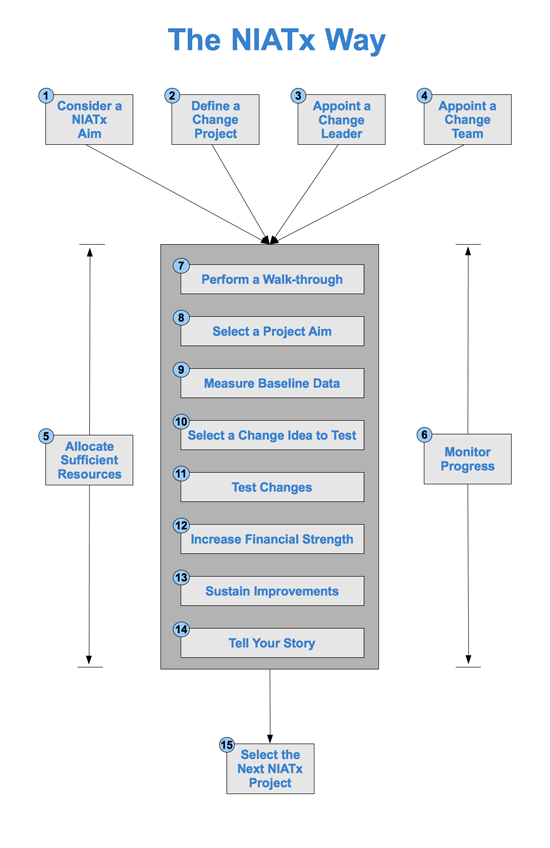Provider Toolkit
- Overview
-
The NIATx Way
- Consider a NIATx Aim
- Define a Change Project
- Appoint a Change Leader
- Appoint a Change Team
- Allocate Sufficient Resources
- Monitor Progress
- How to Perform a Walk-through
- Select a Project Aim
- Measure Baseline Data
- Select a Change Idea to Test
- Test Changes
- Increase Financial Strength
- Sustain Improvements
- Tell Your Story
- Select the Next NIATx Project
- Message to the Executive Sponsor
- Message to the Change Leader
- Sequence of Aims
- Promising Practices
- The Business Case
- Tracking and Measuring Tools
- Process Improvement Tools
- Resources
The NIATx Way
A step-by-step guide to running a successful change project.
- The actions around the outside of the central box (1-6 and 15) are primarily the responsibility of the chief executive leader, called the Executive Sponsor. Read the message to the Executive Sponsor.
- The actions within the box (7-14) are primarily the responsibility of the Change Leader and Change Team, both of which are appointed by the Executive Sponsor.
- Once appointed, the Change Leader should read the message to the Change Leader.
- Both the Change Leader and the Executive Sponsor jointly participate in actions 4—Appoint a Change Team and 7—Perform a Walk-through.
- Actions are numbered to show the recommended sequence of events; you may tailor the sequence to some degree to fit your setting.
If this is your first time through the NIATx Way, download and print the Milestones along the NIATx Way
 . This is a worksheet where you can record your answers to the first seven start-up actions.
. This is a worksheet where you can record your answers to the first seven start-up actions.
Note: Click any of the steps in the NIATx Way to navigate to that section.

1. Consider a NIATx Aim
The first step of the NIATx Way encourages the Executive Sponsor to confirm that one of the NIATx aims (reducing waiting time and no-shows, increasing continuation and admissions) is important to you and your organization.
2. Define a Change Project
Once you have focused on one of the four NIATx aims, define a Change Project to focus on one aim, one level of care, one location, and one population.
3. Appoint a Change Leader
After identifying a Change Project, the Executive Sponsor appoints an influential Change Leader—a member of the staff that is persistent, focused, respected, results-oriented, and who will challenge the status quo.
4. Appoint a Change Team
The Executive Sponsor appoints a team to coordinate the Change Project and implement rapid-cycle changes designed to improve the process.
5. Allocate Sufficient Resources
The Executive Sponsor allocates resources to the Change Project so that the Change Leader can commit sufficient time and energy to the project and so that the Change Team can complete the project successfully in six months or less.
6. Monitor Progress
The Executive Sponsor meets regularly with the Change Leader and monitors the progress of the Change Project to keep the project running smoothly.
7. Perform a Walk-through
Conduct a walk-through so that the members of the Change Team—the Executive Sponsor and the Change Leader in particular—experience what it’s like to be a customer of your agency or facility so that you understand the customer’s perspective and the organizational processes that inhibit access to and retention in treatment.
8. Select a Project Aim
The NIATx model of process improvement focuses on four aims at specific steps in the treatment continuum. Select a specific aim to see specific data-gathering tools and promising practices suited to that aim.
9. Measure Baseline Data
Measuring baseline data is the first step in understanding which changes worked, which changes resulted in an improvement, and which changes resulted in the greatest improvement.
10. Select a Change Idea to Test
Consider changes made by other NIATx organizations and use these promising practices to make changes and to generate your own change ideas.
11. Test Changes
Use the Plan-Do-Study-Act model of rapid-cycle change to quickly test change ideas on a small scale and in limited context. Successful changes can then be spread to the rest of your organization.
12. Increase Financial Strength
Make the connections between improved access and retention and increased revenue, reduced costs, and improved staff morale.
13. Sustain Improvements
After you have made successful changes, the Executive Sponsor appoints a Sustain Leader who focuses on sustaining the improvements that you have made.
14. Tell Your Story
Create a storyboard to communicate the progress—and the success—of your Change Project for audiences both inside and outside your organization.
15. Select the Next NIATx Project
The Executive Sponsor strategically steers the organization project by project. After completing one Change Project, use the success of that project to form the foundation for the next one.



